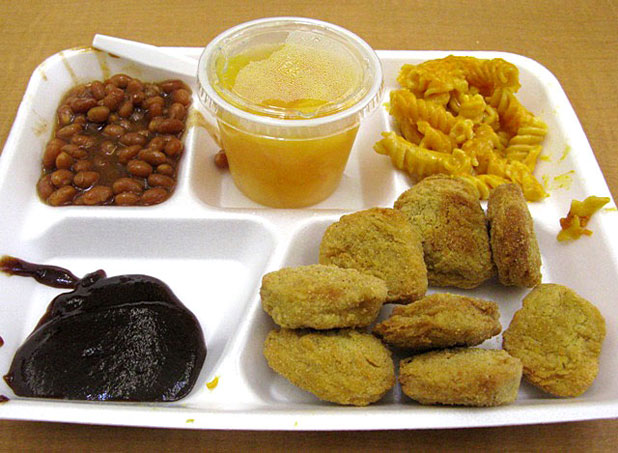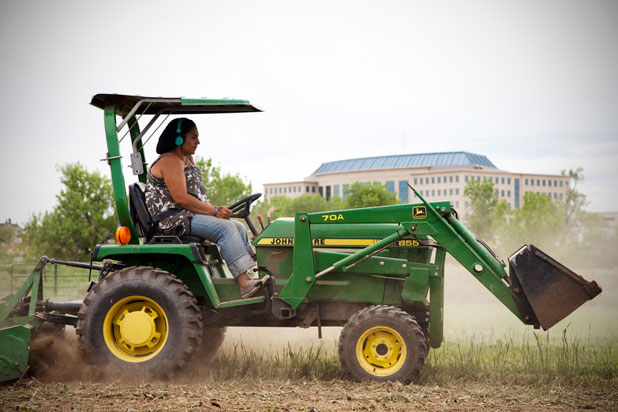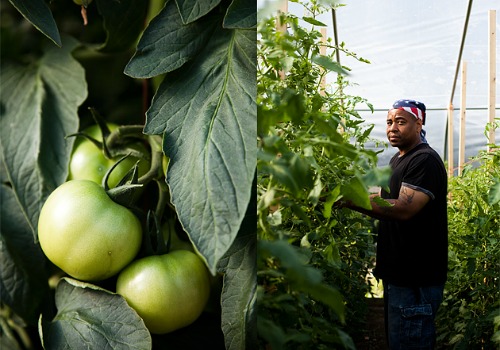January 2011 update: Many of the photos have been removed from this series so they can be published in a Breaking Through Concrete book, forthcoming this year from UC Press.
When we were still in Seattle, preparing for this project, a few friends asked if this was a tour of ‘yuppie urban farm projects.’ Isn’t that who participates in the urban farm? they generalized.
I will now suggest that they take a few laps on their fixed-gear bikes through Denver. This year, the nonprofit Denver Urban Gardens (DUG) will support the construction of its 100th community garden. We only had time to visit four of them in the two days we were in town, but we got a kaleidoscope of ages, ethnicities, socio-economic strata, and motivations: the suburbanites in formerly rural Aurora, African and Asian refugees in East Colfax, school students all over the place, and upper-middle-class professionals in Rosedale.
Delaney Community Farm
Faatma Mehrmanesh rides the John Deer tractor in style. Her long hair fills a woven cloth hat. Turquoise headphones rest on top so she can rock to the tractor’s slow roll over the soil. She’s preparing the plot for its first planting: the growing season starts late here at the base of the Rocky Mountains.
Through the dust thrown up around the tractor, I see the boxy outline of office parks and new residential developments bordering this property, the 30-acre historic Delaney Farm. Driving out here from Denver, you see the classic 20th century progression of urban development: from dense city to industrial warehouses and trucking yards, to big-box retail centers and the modern-day suburban house farm in the town of Aurora. At Delaney, the beige, paved banality opens to green grasses, faded white farm buildings, and row crops colored by a few individuals weeding, harvesting, or watering.
“Even some of my friends just drive by and think this is a site that’s about to be developed. They don’t even know we’re here growing food every day,” says Faatma.
Delaney has a community garden on the front side, but the larger farm is for a Community Supported Agriculture (CSA) program, which has 65 shareholders. Between the CSA and the farm’s social service partnerships with the Women, Infants, and Children and Colorado AIDS programs, it provides food to about 500 families, according to Faatma.
Faatma has a small crew of interns and a larger, more willy-nilly crew of volunteers. On this day, Brandy Gee weeds a row of greens. It’s her first day and she’s here to chill out and be in touch with the earth and to learn about community programs for her business idea, an urban general store. Bill’s here because the court sent him to work off community hours. He’s a city hipster and doesn’t know a thing about Delaney. Then there’s Hamadi Mayange. Hamadi works at the farm most days. He takes the bus out and he brings home a bag of veggies after his day’s work. Mayange is 59, a Somali-Bantu refugee. Everyone in his homeland grows food, so he just likes being around the farm. We will see Hamadi later today as we weave through Denver’s city farm world.
Peace Garden
Between 1992 and 1994 in Denver, gang relations crested a tipping point and murder became a rite of passage for many teenagers. Over 100 young adults were victims of violence. Ana Chavez’s 16-year-old son, Troy, was one of them. Chavez created a foundation named after him, to create hope and reduce gang violence.
Originally she wanted to build a small corner garden as a memorial to her son. But then the entire narrow lot, tarnished with burned-down greenhouses and derelict activity, came available. Ana jumped at it and, in 1994, with the help of some neighbors and some heavy-duty, syringe-proof work gloves, cleaned it up.
“We didn’t have any money,” she recalls. “We put a prayer here. We visioned it, as a community. Then things just started happening. DUG heard about us and offered skills and connections. We talked to young kids about their elders and their ancestors, the indigenous people of Mexico and Guatemala. A lot of those kids who started the garden had buried their friends. They wanted a place to remember them, but also to feel safe and to find themselves.”
So Ana and the kids designed the garden in the form of an Aztec Ball Court, with two ceremonial courtyards at the front surrounded by medicinal plantings like sage, yerba buena, St. John’s wort, echinacea, comfrey, rosemary, and ceremonial tobacco. In the back half of the garden, a local alternative school manages crops alongside community plots.
“We teach the kids about the old ways of our people,” says Ana. “We’ve always been agricultural and connected to the land. This isn’t new. We just want to bring it to the kids so we don’t lose it. But I also tell the kids all the time, ‘You belong here. You’re not a foreigner. You have responsibilities here.’ That leads to pride and ownership and care for your place.”
Peace Garden has been working for 16 years, but there is still violence. A teenager named Jeremy was shot recently. His home life had been a wreck, and the garden had been his refuge, Ana says.
East 13th Street Garden
It’s hard to miss this garden on a summer afternoon. The whole neighborhood around Yosemite and East Colfax seems to move faster and brighter and freer than most city blocks. Teens swerve on BMX bikes, people jaywalk across streets, and kids splash in the creek beside the sidewalk.
Amidst it all there’s this patch of green surrounded by a chain-link fence. While the vegetation softens the look relative to the surrounding pavement, the commotion and color remain the same inside. Women wrapped in red-and-gold-seamed shawls and long, flowing dresses crouch to weed small beds of baby shoots. Kids sit under a tree sucking mangos on sticks sold by a woman with a pushcart on the sidewalk. Men are here, too. They water and weed and chat with each other. Few people speak English.
Abukar Maye does. He’s 28, a Somali-Bantu who spent 10 years in a Kenya refugee camp. He works security at a Hyatt Hotel and he lives “with Americans,” meaning a neighborhood separate from this largely refugee one. I ask him why this garden is so thriving with people and energy.
“We come to the gardens because we want to do something that reminds us of Africa,” he says. “If I am in Somalia, I am going to make a lot of fruit. To have a garden is fun. The food is fresh and it’s better than staying inside the house.”
Then Hamadi Mayange, who we met at the Delaney Farm, shows up. He’d been out running an errand but this is where he comes when he leaves Delaney. Hamadi is the garden leader, the elder statesman of sorts. He and Abukar speak to one another in their native language, Maay Maay.
Abukar, who speaks English better than Hamadi does, says the mix of races at the garden is a challenge: “We can’t speak to one another very well. Before, when Hamadi told children to sit under the tree and when he gave rules, everyone listens. Now sometimes people do things like play football in the garden.”
Abukar, who is one of the proudest American citizens I have met, responds with the best line of the day, “But since this is America, we cannot beat them.”
Some old forms don’t fly in the new land, though I’d love to see Abukar chase down a young hooligan with a switch.
Rosedale Garden
The Rosedale Garden unfolds in the corner of a grassy park. We meet Carol Garcia, one of seven steering committee leaders, there in the late afternoon. The 90 plots range from elaborate raised beds to smart geometric designs of veggies and flowers.
This is the garden that my Seattle friends perhaps were imagining, in an upper-middle class neighborhood of modest, tidy homes; sidewalks; old, stately trees; people jogging and walking dogs; and the University of Denver a few blocks away.
I ask Garcia why she thinks applications for plots have increased enough to necessitate a waiting list. She says she thinks people just want more and more local food that doesn’t come from big companies, and that people take part for the enjoyment and for the challenge.
I guess I wasn’t too far off from my Seattle friends’ perception of urban gardens and gardeners. When we pulled up, I immediately judged Rosedale as a hobby garden, a cute diversion for people who could buy all the organic produce they wanted at Whole Foods — nothing like the noble pursuit of necessity exhibited at the East 13th garden or the statement for community and heritage at the Peace Garden.
But that’s silly as hell. Though the neighborhoods and the people look different, they are all just community places where people share while tending to the food they eat. And, like any community, the individuals in all four gardens range from wanna-be gardeners who bail after July 4th to dedicated growers committed year after year to people just looking for a safe place.
The only generalization left after this long day is that the people in these gardens look comfortable and connected, as if they’re at home.




